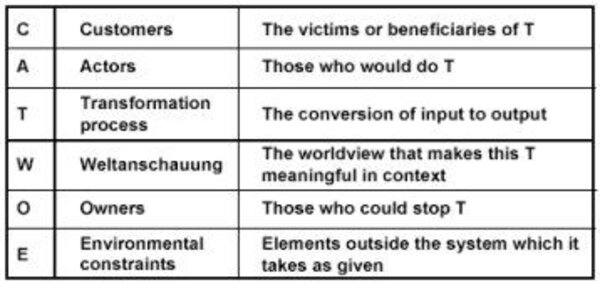CATWOE
CATWO, which is the acronym for Clients, Actors, Weltanschauung, Owners, and Environment, is a simple checklist that stimulates thinking concerning problems and solutions. This method enables to take a 360-degree look around a situation by observing these aspects and understanding their interrelation to each other, considering where the emphasis lies and potentially detect any involved risks.
Organisation
-
Duration
Medium (about 30-60 minutes)
-
Complexity
Medium
-
Group size
1 to 50 persons
This activity is suitable online.
Description Long
CATWOE is a mnemonic for a checklist for problem or goal definition, and was originally defined by Peter Checkland in order to describe a human activity and its situation as a part of his Soft Systems Methodology (SSM). This method is one of the generic techniques that foster Business Analyst to identify what the business is trying to achieve, uncover the problem areas and reveal the impact of the solution on business and people involved in it. CATWOE is applied to the system, which contains the problem, issue or solution, rather than to the problem or goal itself:
C- The customers of the system. In this context, customer means those who are on the receiving end of whatever it is that the system does. Is it clear from your definition who will gain or lose?
A- The actors, meaning those who would actually carry out the activities envisaged in the notional system being defined.
T- The transformation process. What does the system do to the inputs to convert them into the outputs.
W- The Weltanschauung (world view) that lies behind the root definition. Putting the system into its wider context can highlight the consequences of the overall system. For example, the system may be in place to assist in making the world environmentally safer, and the consequences of system failure could be significant pollution.
O- The owner(s) - i.e. those who have sufficient formal power over the system to stop it existing if they so wished (though they won't usually want to do this).
E- The environmental constraints. These include things such as ethical limits, regulations, financial constraints, resource limitations, limits set by terms of reference, and so on.
Illustration

Preparation
- Define a problem or solution you want to work on.
Online: Make sure that people can discuss in small groups online..
Execution
- Comment on the problem or Solution. The participants should think about it in the following 6 aspects (In groups or individually):
- Customers: Who receives the outcome of this process: is it beneficial to them or an endangerment?
- Actors: In this scenario, try to determine the person who has an active role and is responsible for the activities being carried out, while considering participates and those who should be informed.
- Transformation Process: List the series of actions or activities that should take place to transforms the inputs into the outputs.
- Weltanschauung: Consider the system of beliefs or values that are involved.
- Owners: Identify the people who have the power to stop this goal being realized or this problem coming to a solution.
- Environmental Restraints: List the influences from the environment that will have an impact on the situation (e.g. regulatory affairs, resources limitations, ethical issues, etc.)
Hints from experience
Note that the outcome of this technique may not include all the 6 aforementioned aspects. What is important is to use all these dimenstion to make sure that you covered all the aspects and determining whether they should be taken into consideration or not.
References
BusinessOnlineLearning,. How CATWOE Works. Retrieved 8 August 2015, from http://www.business-online-learning.com/catwoe.html
Checkland, P.B. (1981). Systems Thinking, Systems Practice. John Wiley & Sons Ltd.
Kowaltowski, D. C., Bianchi, G., & De Paiva, V. T. (2010). Methods that may stimulate creativity and their use in architectural design education. International Journal of Technology and Design Education, 20(4), 453-476. Retrieved from, https://www.academia.edu/527010/Methods_that_may_stimulate_creativity_and_their_use_in_architectural_design_education
Mycoted.com,. (2008). CATWOE - Mycoted. Retrieved 8 August 2015, from, http://www.mycoted.com/CATWOE
www.studycampus.com